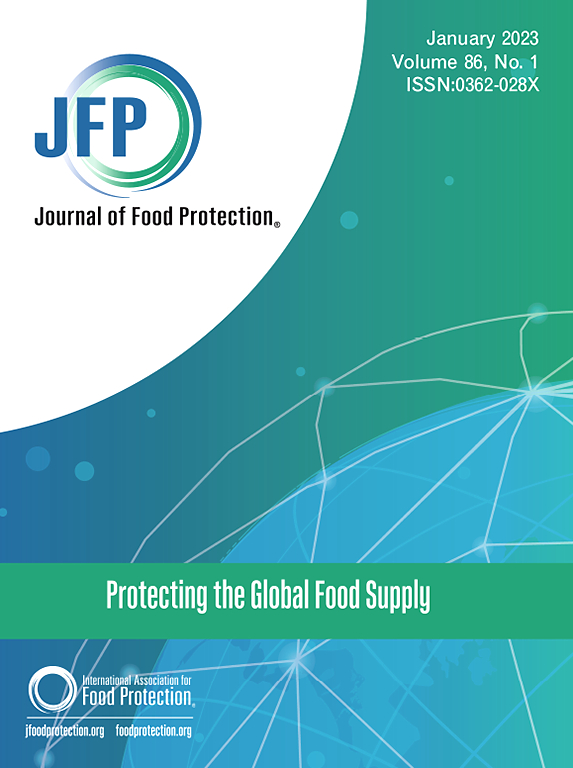Development of a Flexible Produce Supply Chain Food Safety Risk Model: Comparing Tradeoffs Between Improved Process Controls and Additional Product Testing for Leafy Greens as a Test Case
IF 2.1
4区 农林科学
Q3 BIOTECHNOLOGY & APPLIED MICROBIOLOGY
引用次数: 0
Abstract
The produce industry needs a tool to evaluate food safety interventions and prioritize investments and future research. A model was developed in R for a generic produce supply chain and made accessible via Shiny. Microbial contamination events, increases, reductions, and testing can be modeled. The output for each lot was the risk of one, 300-gram sample testing positive, described by two industry-relevant risk metrics, the overall risk of a positive test (proxy for recall risk) and the number of lots with the highest risk (>1 in 10 chance) of testing positive (proxy for public health risk). A leafy green supply chain contaminated with Shiga-toxin-producing Escherichia coli was modeled with a mean of 1 pathogen cell per pound (µ = 1 CFU/lb or −2.65 Log(CFU/g)) under high (σ = 0.8 Log(CFU/g)) and low (σ = 0.2 Log(CFU/g)) variability. Baseline risk of a positive test in the low-variability scenario (1 in 20,000) was lower than for high-variability (1 in 4,500), showing rare high-level contamination drives risk. To evaluate tradeoffs, we modeled two well-studied, frequently used interventions: additional product testing (8 of 375-gram tests/lot) and improved process controls (additional −0.87 ± 0.32 Log(CFU/g) reduction). Improved process controls better-reduced recall risk (to 1 in 115,000 and 1 in 26,000 for low- and high-variability, respectively), compared to additional product testing (to 1 in 21,000 and 1 in 11,000 for low- and high-variability, respectively). For low variability contamination, no highest-risk lots existed. Under high variability contamination, both interventions removed all highest-risk lots (about 0.05% of total). Yet, additional product testing rejected more lower-risk lots (about 1% of total), suggesting meaningful food waste tradeoffs. This model evaluates tradeoffs between interventions using industry-relevant risk metrics to support decision-making and can be adapted to assess other commodities, process stages, and less-studied interventions.
开发灵活的农产品供应链食品安全风险模型:以绿叶菜为例,比较改进流程控制与额外产品检测之间的权衡。
农产品行业需要一种工具来评估食品安全干预措施,并确定投资和未来研究的优先次序。我们用 R 语言为通用农产品供应链开发了一个模型,并可通过 Shiny 访问。可以对微生物污染事件、增加、减少和检测进行建模。每个批次的输出结果是一个 300 克样本检测呈阳性的风险,由两个行业相关风险指标来描述,即检测呈阳性的总体风险(代表召回风险)和检测呈阳性风险最高(>1/10 的概率)的批次数量(代表公共卫生风险)。在高(σ=0.8 Log(CFU/g))和低(σ=0.2 Log(CFU/g))变异性条件下,绿叶蔬菜供应链受到产志贺毒素大肠杆菌污染的平均值为每磅 1 个病原体细胞(μ=1 CFU/lb 或 -2.65 Log(CFU/g))。低变异性情况下的阳性检测基线风险(20,000 分之 1)低于高变异性情况下的阳性检测基线风险(4,500 分之 1),这表明罕见的高水平污染推动了风险。为了评估权衡,我们模拟了两种经过充分研究的常用干预措施:额外的产品检测(每批 375 克检测 8 次)和改进的过程控制(额外减少 -0.87±0.32 Log(CFU/g) )。与额外的产品检测(低变异性和高变异性分别为 21,000 分之 1 和 11,000 分之 1)相比,改进流程控制能更好地降低召回风险(低变异性和高变异性分别为 115,000 分之 1 和 26,000 分之 1)。在低变异性污染情况下,不存在最高风险批次。在高变异性污染情况下,两种干预措施都剔除了所有最高风险批次(约占总数的 0.05%)。然而,额外的产品检测会剔除更多的低风险批次(约占总数的 1%),这表明食物浪费的权衡是有意义的。该模型利用与行业相关的风险指标来评估干预措施之间的权衡,以支持决策,并可用于评估其他商品、流程阶段和研究较少的干预措施。
本文章由计算机程序翻译,如有差异,请以英文原文为准。
求助全文
约1分钟内获得全文
求助全文
来源期刊

Journal of food protection
工程技术-生物工程与应用微生物
CiteScore
4.20
自引率
5.00%
发文量
296
审稿时长
2.5 months
期刊介绍:
The Journal of Food Protection® (JFP) is an international, monthly scientific journal in the English language published by the International Association for Food Protection (IAFP). JFP publishes research and review articles on all aspects of food protection and safety. Major emphases of JFP are placed on studies dealing with:
Tracking, detecting (including traditional, molecular, and real-time), inactivating, and controlling food-related hazards, including microorganisms (including antibiotic resistance), microbial (mycotoxins, seafood toxins) and non-microbial toxins (heavy metals, pesticides, veterinary drug residues, migrants from food packaging, and processing contaminants), allergens and pests (insects, rodents) in human food, pet food and animal feed throughout the food chain;
Microbiological food quality and traditional/novel methods to assay microbiological food quality;
Prevention of food-related hazards and food spoilage through food preservatives and thermal/non-thermal processes, including process validation;
Food fermentations and food-related probiotics;
Safe food handling practices during pre-harvest, harvest, post-harvest, distribution and consumption, including food safety education for retailers, foodservice, and consumers;
Risk assessments for food-related hazards;
Economic impact of food-related hazards, foodborne illness, food loss, food spoilage, and adulterated foods;
Food fraud, food authentication, food defense, and foodborne disease outbreak investigations.
 求助内容:
求助内容: 应助结果提醒方式:
应助结果提醒方式:


